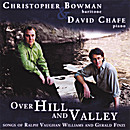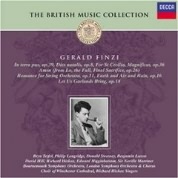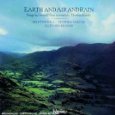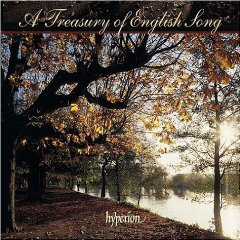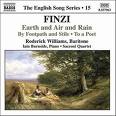Rollicum-Rorum
Poet: Thomas Hardy
Date of poem: 1878
Publication date: 1880 The Trumpet Major
Publisher:
Collection: Wessex Poems (1898)
History of Poem:
Poem
The Seargeant's Song |
||
|---|---|---|
Finzi's title: Rollicum-Rorum |
||
| 1 | When Lawyers strive to heal a breach, | |
| 2 | And Parsons practise what they preach; | |
| 3 | Then Boney he'll come pouncing down, | |
| 4 | And march his men on London town! | |
| 5 | Rollicum-rorum, tol-lol-lorum, | |
| 6 | Rollicum-rorum, tol-lol-lay! | |
| 7 | When justices hold equal scales, | |
| 8 | And Rogues are only found in jails; | |
| 9 | Then Boney he'll come pouncing down, | |
| 10 | And march his men on London town! | |
| 11 | Rollicum-rorum, tol-lol-lorum, | |
| 12 | Rollicum-rorum, tol-lol-lay! | |
| 13 | When Rich Men find their wealth a curse, | |
| 14 | And fill therewith the Poor Man's purse; | |
| 15 | Then Boney he'll come pouncing down, | |
| 16 | And march his men on London town! | |
| 17 | Rollicum-rorum, tol-lol-lorum, | |
| 18 | Rollicum-rorum, tol-lol-lay! | |
| 19 | When Husbands with their Wives agree, | |
| 20 | And Maids won't wed from modesty; | |
| 21 | Then Boney he'll come pouncing down, | |
| 22 | And march his men on London town! | |
| 23 | Rollicum-rorum, tol-lol-lorum, | |
| 24 | Rollicum-rorum, tol-lol-lay! | |
(Hardy, 18-9) |
||
Content/Meaning of the Poem:
Speaker:
Setting:
Purpose:
Idea or theme:
Style:
Form:
Synthesis:
Published comments about the poem:
✦✼✦✼✦✼✦✼✦✼✦✼✦✼✦✼✦✼✦✼✦✼✦✼✦✼✦✼✦✼✦✼✦✼✦
✦✼✦✼✦✼✦✼✦✼✦✼✦✼✦✼✦✼✦✼✦✼✦✼✦✼✦✼✦✼✦✼✦✼✦
Musical Analysis
Composition date:
Publication date:
Publisher: Boosey & Hawkes - Distributed by Hal Leonard Corporation
Tonality:
Transposition:
Duration:
Meter:
Tempo:
Form:
Rhythm:
Melody:
Texture:
Vocal Range:
Tessitura:
Dynamic Range:
Accompaniment:
Published comments about the music:
Pedagogical Considerations for Voice Students and Instructors:
✦✼✦✼✦✼✦✼✦✼✦✼✦✼✦✼✦✼✦✼✦✼✦✼✦✼✦✼✦✼✦✼✦✼✦
✦✼✦✼✦✼✦✼✦✼✦✼✦✼✦✼✦✼✦✼✦✼✦✼✦✼✦✼✦✼✦✼✦✼✦
| Pitch Analysis | ||||||
|---|---|---|---|---|---|---|
| pitch | stanza 1 |
stanza 2 |
stanza 3 |
stanza 4 |
total | |
highest |
A |
|||||
G |
||||||
F |
||||||
E |
||||||
D |
||||||
middle C |
||||||
B |
||||||
A |
||||||
G |
||||||
F |
||||||
lowest |
E |
|||||
| Rhythm Duration Analysis of Vocal Line | |||||
|---|---|---|---|---|---|
| stanza 1 | stanza 2 | stanza 3 | stanza 4 | total | |
16th note |
|||||
8th note |
|||||
dotted 8th |
|||||
quarter note |
|||||
dotted quarter |
|||||
triplet |
|||||
half note |
|||||
dotted half |
|||||
stanza total |
|||||
✦✼✦✼✦✼✦✼✦✼✦✼✦✼✦✼✦✼✦✼✦✼✦✼✦✼✦✼✦✼✦✼✦✼✦
Audio Recordings
Over Hill and Valley: Songs of Ralph Vaughan Williams and Gerald Finzi |
|
|
|
The British Music Collection: Gerald Finzi |
|
|
|
Song Recital |
|
|
|
Songs: Brahms - Faure - Finzi - Schubert |
|
|
|
The Songs of Gerald Finzi to Words by Thomas Hardy
|
|
|
|
A Treasury of English Song |
|
|
|
Gerald Finzi |
|
|
|
The English Song Series - 15 |
|
|
|
✦✼✦✼✦✼✦✼✦✼✦✼✦✼✦✼✦✼✦✼✦✼✦✼✦✼✦✼✦✼✦✼✦✼✦
The following is an analysis of Rollicum - Rorum by Gerhardus Daniël Van der Watt. Dr. Van der Watt extended permission to post this excerpt from his dissertation on October 8th, 2010. His dissertation dated November 1996, is entitled:
The Songs of Gerald Finzi (1901-1956) To Poems by Thomas Hardy
This excerpt comes from Volume II and begins on page 208 and concludes on page 215. To view the methodology used within Dr. Van der Watt's dissertation please refer to: Methodology - Van der Watt.
1. Poet
Specific background concerning poem:
"The Sergeant's Song" was written in 1878, first published in the serialized novel, The Trumpet Major (1880) and later published again in Wessex Poems (1898). Martin Seymour-Smith says the following about the novel:
The Trumpet Major is a remarkable historical reconstruction, because it concentrates upon only a few square miles of England and gives the most convincing picture ever drawn of just what the Napoleonic threat meant to those immediately involved. (Seymour-Smith, 256)
Hardy has the following to say in the preface to the 1895 volume publication:
the present tale is founded more largely on testimony - oral and written - than any other in this series. The external incidents which direct its course are mostly an unexaggerated reproduction of the recollection of old persons well known to the author in childhood, but now long dead, who were eye-witnesses of those scenes.
In the novel, "The Sergeant's Song" is dated 1803 and it a typical soldier's song of external bravery or inspiring courage, saying that "Boney" (Napoleon Boneparte) will not ever be able to invade England.
2. Poem
The Sergeant's Song |
||
|---|---|---|
| 1 | When Lawyers strive to heal a breach, | a |
| 2 | And Parsons practise what they preach; | a |
| 3 | Then Boney he'll come pouncing down, | b |
| 4 | And march his men on London town! | b |
| 5 | Rollicum-rorum, tol-lol-lorum, | c |
| 6 | Rollicum-rorum, tol-lol-lay! | d |
| 7 | When justices hold equal scales, | e |
| 8 | And Rogues are only found in jails; | e |
| 9 | Then Boney he'll come pouncing down, | b |
| 10 | And march his men on London town! | b |
| 11 | Rollicum-rorum, tol-lol-lorum, | c |
| 12 | Rollicum-rorum, tol-lol-lay! | d |
| 13 | When Rich Men find their wealth a curse, | f |
| 14 | And fill therewith the Poor Man's purse; | f |
| 15 | Then Boney he'll come pouncing down, | b |
| 16 | And march his men on London town! | b |
| 17 | Rollicum-rorum, tol-lol-lorum, | c |
| 18 | Rollicum-rorum, tol-lol-lay! | d |
| 19 | When Husbands with their Wives agree, | g |
| 20 | And Maids won't wed from modesty; | g |
| 21 | Then Boney he'll come pouncing down, | b |
| 22 | And march his men on London town! | b |
| 23 | Rollicum-rorum, tol-lol-lorum, | c |
| 24 | Rollicum-rorum, tol-lol-lay! | d |
(Hardy, 18-9) |
||
The persona of the poem is an English army sergeant in the early nineteenth century. It can be seen as a drinking song with a nonsense-refrain for everyone to sing along. The R-alliteration of the nonsense-refrain makes the sound-effect onomatopoeic of a military snare-drum roll. A list of things which are most unlikely to happen, is given as conditions for Napoleon's (Boney's) invasion of London. The list includes a range of society from governmental institutions ("Justices"), the Church ("Parsons"), professions ("Lawyers"), to individuals ("Rogues, Rich men, Poor men, Husbands and Wives, Maids"). The implication is that the chances of a French invasion are so slight that man's nature will first have to change before it can take place:
"When" human nature changes...
"Then Boney he'll come pouncing down"
There is strong satire present in the poem, ridiculing war and human nature and its follies. There is also some military bravado present in the song due to the fact that it was quite possible for Napoleon to invade England at the time (since he invaded just about every other country). The persona deems this invasion as impossible as changing human behavior. On the other hand, the poet through the persona, makes caustic comment on the stereotyped vices of human behavior:
- Lawyers do not really try to heal breaches permanently, because these are their livelihood.
- Parsons do not really practise what they preach, because the true Christian way of life is hard to follow.
- Justice in human hands is a frail and shaky matter.
- Many Rogues are too clever to be caught due to flaws in the system of justice.
- Rich men are seldom prepared to give away their money to the poor.
- Husbands and their wives hardly ever agree.
- Maidens are supposedly disinclined to marry while all nineteenth century society knew that the over-riding aim of girls (and their mothers) was to find them a husband.
The poem has the style of a light-hearted folk song or drinking song and has the typical robustness and bluntness associated army barracks and rustic thinking.
The four stanzas can be divided in two different ways:
- Visually it consists of a quatrain (two rhyming couplets) and a nonsense-refrain
- Semantically it consists of a rhyming couplet and a four-line refrain, since the text for the last four lines of the poem is the same in every stanza. (couplet + refrain of two couplets)
The rhyme scheme is aabbcd eebbcd ffbbcd ggbbcd and the metre iambic throughout except for the fifth line of each stanza which opens with a single dactylic foot.
The simple style including a nonsense-refrain supports the satirical light-hearted tone of the poem. Particular circumstances in the novel, The Trumpet Major, generate the song but it develops into a universal statement on human nature: human hopes and fears, virtues and vices are playfully satirized in the shadow of the threat of war.
Setting
1. Timbre
VOICE TYPE/RANGE
The song is set for baritone and the range is a perfect twelfth from the second A below middle C.
The piano accompaniment covers a range of close to six octaves. The bulk of the song, however, is accompanied in the middle to low register, the extreme high register only used in an isolated spot, namely in bars ![]() as part of the variation in the accompaniment and vocal material in stanza four. This register change is related to the meaning of the text only in a general way by creating a sense of fun before the final nonsense-refrain. The lower register is used effectively to help create a sense of robustness and directness (b. 3-6, 21-24, 36-38, 45-52, 59-60, 67-70, 95-99). A lot of rests are used in the accompaniment (in 44 of the 99 bars or 44% of the bars) to prevent the rather thick piano texture from overpowering the voice. There are no indications for pedal use and the pedal should be used sparingly as a means to accentuate the relevant moments (b. 5, 22-23, 45-46, 67-69, 74, 84-87, 95-99).
as part of the variation in the accompaniment and vocal material in stanza four. This register change is related to the meaning of the text only in a general way by creating a sense of fun before the final nonsense-refrain. The lower register is used effectively to help create a sense of robustness and directness (b. 3-6, 21-24, 36-38, 45-52, 59-60, 67-70, 95-99). A lot of rests are used in the accompaniment (in 44 of the 99 bars or 44% of the bars) to prevent the rather thick piano texture from overpowering the voice. There are no indications for pedal use and the pedal should be used sparingly as a means to accentuate the relevant moments (b. 5, 22-23, 45-46, 67-69, 74, 84-87, 95-99).
Articulation is indicated very meticulously in the song. There are 34 bars in which staccatos are used to create a spiky or biting character which enhances the satire in the text. A small number of staccato accents are used in bars 21-22 while half-staccatos are found in bars 36-37, 47-48, 57, 60-61, 70-71, and 88. the most prominent articulation feature of the song is the detached manner of playing; a feature in complete agreement with the character of the song. There are 27 portamento accents, used to prolong certain notes against others in the same context which are staccato or accompanied by rests (b. 3, 36, 39, 49, 56, 60, 65, 72).
A leading clue to the intention of the composer concerning the atmosphere that he was trying to create, lies in the two tempo and character indications at the beginning of the song: Allegro Robusto and Pesante. The articulation, accents, dynamic indications, rhythmic material and lively tempo throughout, all support the initial indications. A uniform atmosphere of fun, satire, liveliness and country robustness is effectively achieved in the accompaniment of the song.
2. Duration
METRE
The text consists of iambic tetrameters virtually throughout with the exception of the dactylic foot at the beginning of the fifth line of every stanza. The musical metre follows closely with simple duple time-signature except for four bars where the time-signature is simple triple time (b. 10, 33, 56, 79) in order to prolong the final word of the phrase before the start of the refrain. This metric change is hardly necessary (a dotted quaver and semi-quaver would have sufficed) and is therefore explicitly deliberate both for the above mentioned reason and in order to create a sense of the metre being deliberately "wrong" as if it could not be kept properly by the rustic singer. Inserting the occasional extra beat into a bar is in keeping with the satirical atmosphere suggested by the poem.
Rhythmic motifs
The strongest rhythmic motif common between voice and piano consists of four quavers (motif 1) and occurs 47 times (in 47% of the bars). The first variation on this motif has a dotted quaver and semi-quaver in stead of the first beat (motif 2) and occurs 14 times (in 14% of the bars). A further variation on motif 1, restricted to the use of the voice in its entirety - although fragments occur in the piano part - consists of two semi-quaver and a quaver instead of the first beat (motif 3) occurs 16 times (in 16% of the bars). Motif 4, consisting of four semi-quavers only occurs in the piano part and is used 13 times (in 13% of the bars). Motif 5, consisting of two crotchets also restricted to use in the piano part, occurs 14 times and is mostly accompanied by the use of a portamento accent. Finally, the most used motif which consists of a quaver rest and quaver or the inverse (motif 6), is used 79 times in the piano part only. These motifs which are all uncomplicated rhythmically and closely related to one another, are instrumental in the realization of the unsophisticated, boisterous atmosphere.
Rhythmic activity vs. Rhythmic stagnation
The song is rhythmically active and the momentum is unyielding, much like soldiers marching. The only deviation from this principle is the prolonged notes at the end of vocal phrases. These do not interrupt the rhythmic flow but rather provide a break from the rhythmic jerkiness of the rest of the song while it helps to round off, by indicating the ends of phrases (b. 22-24, 45-57, 68-70, 84-87, 95-99).
Rhythmically perceptive, erroneous and interesting settings
The following words have been perceptively or interestingly dealt with rhythmically:
Lengthening of voiced consonants
The only voiced consonant that has been prolonged rhythmically, occurs in the word "town" as used in bars 14, 37, 60 and 84-87. In the final example the word is rhythmically distorted to fulfil a musical function.
The tempo indication is Allegro robusto ![]() and there is no deviation from this indication. This relentless forward movement is in keeping with the general character of the song and also in keeping with the character of a folk song.
and there is no deviation from this indication. This relentless forward movement is in keeping with the general character of the song and also in keeping with the character of a folk song.
3. Pitch
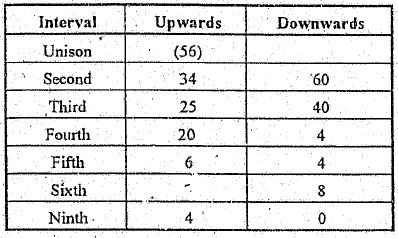
There are 56 repeated pitches 921%), 93 rising intervals (35%) and 116 falling intervals (44%). The smaller intervals (repeated pitches, seconds and thirds) account for 215 of the total or 81% while the larger intervals (a fourth and larger) are 50 or 19% of the total of intervals used in the vocal line. The sharp difference in number between smaller and larger intervals indicates the composer's sensitive attitude to the limitations of the voice. A number of specific settings are given in the following table:

Melodic curve
A melodic curve of the vocal line is represented below. Specific words are indicated to show the relationship between the melodic curve and the meaning:

Vocal Climaxes

The vocal climaxes are not particularly strongly linked to the meaning other than in a rather general way. The climax which occurs in the piano part in bar 84, prior to the final presentation of the nonsense-refrain, is melodically and harmonically far more important. The highest pitch occurs here against a ![]() chord-cluster while the voice has a pedal note on the dominant note.
chord-cluster while the voice has a pedal note on the dominant note.
Phrase lengths
The phrases are quite long and no specific moments for breathing have been indicted. Notes at the end of phrases in the text have to be shortened slightly for purposes of breathing. These will be in the following bars of stanza 1 (and at parallel places for the other stanzas): 10, 14 and 18.
The basic key is D major with a single modulation that occurs in each stanza at the same place and in the prelude (b. 3) at the parallel place. The modulation is to the upper minor third related key of F major. This tonal shift supports the robustness and satire suggested in the text and occurs just before the last repetition of the nonsense-text: "Rollicum rorum tol-lol-lay!" (b. 21, 44, 67, 94).
Chromaticism
The song is tonal with the odd B flat and A flat interjected for the sake of adding colour or spice to an extended chord:
B flat b. 5-6, 97-98
A flat b. 23, 46, 69, 96
These notes are there to bolster the fun-element in the ditty and are not serious harmonic considerations. Their recurrence, however, makes them important binding elements in the song.
HARMONY AND COUNTERPOINT

Non-harmonic tones
There are a number of suspensions and accented passing notes, none of which are important beyond them being part of Finzi's stylistic features. The vocal acciacatura on the word "pouncing" (b. 12, 35, 59, 82) deserves to be mentioned due to its direct relation with the immediate context and reinforcement of the meaning.
Harmonic devices

Counterpoint
There is very little imitation between piano and voice due to the folk song influence. There are two little hints of imitation between piano and voice in bars 24-25 and 70-71, of a motif vaguely related to the opening voice material. These subtle cross-references help to make a tight unit of the song.
Loudness variation is given in the following summary:
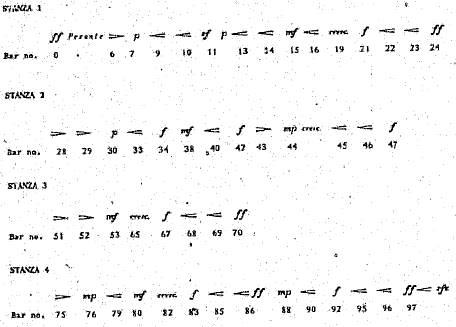
FREQUENCY
There are 56 dynamic indications in the 99 bars (57% of the bars contain indications). There are no separate indications for the voice which implies that the voice should follow the indications in the piano part.
RANGE
The loudest indication is ff coupled with sfz. These indications occurs in bar 97, the third last bar as a final climax just before the end. The lowest dynamic level, p occurs three times. The first is in bar 7 at the opening of the song, then in bar 11, following an sf with the first reference to "Boney" and also in bar 30 at the start of the second stanza. The remaining stanzas start with an mp indication.
VARIETY
Indications used are:
Only six of the indications are mp and lower. The rest are higher and in keeping with the vigorous character of the song.
DYNAMIC ACCENTS
There are two types of accent which occur several times: ^, 21 times and >, 13 times. Both of these are used to emphasize certain aspects of the sound in the accompaniment in keeping with the playful and rustic atmosphere of the song.
the density varies loosely between two and eight parts including both piano and voice. The thickness of the piano part is represented in the following table:
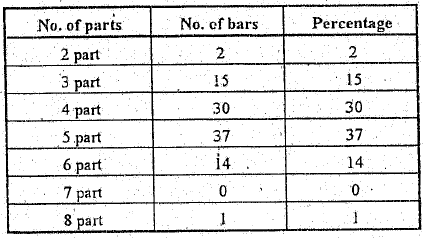
the four- and five-part texture dominates (in 67% of the bars) and if the six-part texture is added 81% of the bars are accounted for. This fairly thick texture is made accessible by the use of rests and staccato articulation. The result is textural transparency in spite of four- to six-part chords.
The structure of the song can be represented in the following table:

The song is strophic in spite of the very small variations in the final stanza. The different A-sections which have been assigned account for the variation in the accompaniment of each stanza. The strophic form of the song is in keeping with the general atmosphere, bucolic simplicity and folk song characteristics.
7. Mood and atmosphere
The mood and atmosphere of the song is uniform throughout. The text and music suggest satire, irony, typical country-merrymaking and even a certain rustic crudeness. The composer achieves these results with sharp accents, dynamic contrast, tonal harmony with abrupt shifts, rests and deliberately uneven changes of metre.
General comment on style
The voice is handled sensitively and sympathetically without being narrow in the use. The occurrence of four minor ninth intervals ensures that. The undertone of the Napoleonic war is deliberately avoided in a sham of jollity which is typical of the soldiering fraternity who often sing or play to escape the reality of their situation. This deliberate attempt to be jolly, reassuring and courageous, is masterfully captured by Finzi.
Unpublished Analysis Excerpts
The following is an analysis of Rollicum-Rorum by Curtis Alan Scheib. Dr. Scheib extended permission to post this excerpt from his dissertation on February 17th, 2012. His dissertation dated 1999, is entitled:
Gerald Finzi's Songs For Baritone On Texts By Thomas Hardy: An Historical And Literary Analysis And Its Effect On Their Interpretation
This excerpt begins on page forty-three and concludes on page forty-four.
The Sergeant's Song |
||
|---|---|---|
Finzi's title: Rollicum-Rorum |
||
| When Lawyers strive to heal a breach, | ||
| And Parsons practise what they preach; | ||
| Then Boney he'll come pouncing down, | ||
| And march his men on London town! | ||
| Rollicum-rorum, tol-lol-lorum, | ||
| Rollicum-rorum, tol-lol-lay! | ||
| When justices hold equal scales, | ||
| And Rogues are only found in jails; | ||
| Then Boney he'll come pouncing down, | ||
| And march his men on London town! | ||
| Rollicum-rorum, tol-lol-lorum, | ||
| Rollicum-rorum, tol-lol-lay! | ||
| When Rich Men find their wealth a curse, | ||
| And fill therewith the Poor Man's purse; | ||
| Then Boney he'll come pouncing down, | ||
| And march his men on London town! | ||
| Rollicum-rorum, tol-lol-lorum, | ||
| Rollicum-rorum, tol-lol-lay! | ||
| When Husbands with their Wives agree, | ||
| And Maids won't wed from modesty; | ||
| Then Boney he'll come pouncing down, | ||
| And march his men on London town! | ||
| Rollicum-rorum, tol-lol-lorum, | ||
| Rollicum-rorum, tol-lol-lay! | ||
(Hardy, 18-9) |
||
The poem was published by Hardy in The Trumpet Major (1880) and conveys an uncharacteristic lightness of humor. Finzi's setting uses a strophic form, which is also uncharacteristic in his song style. The effect is one of a light-hearted drinking song. This was one of the two songs that Boosey and Hawkes also published separately, against Finzi's wishes, as the publisher felt that its tuneful manner would find an easy popularity. Finzi places the song in D major with an Allegro robusto tempo indication. The accompaniment, as seen in example 10, maintains a bright eighth-note motion throughout with generous use of syncopation to set up the beginning of each verse.
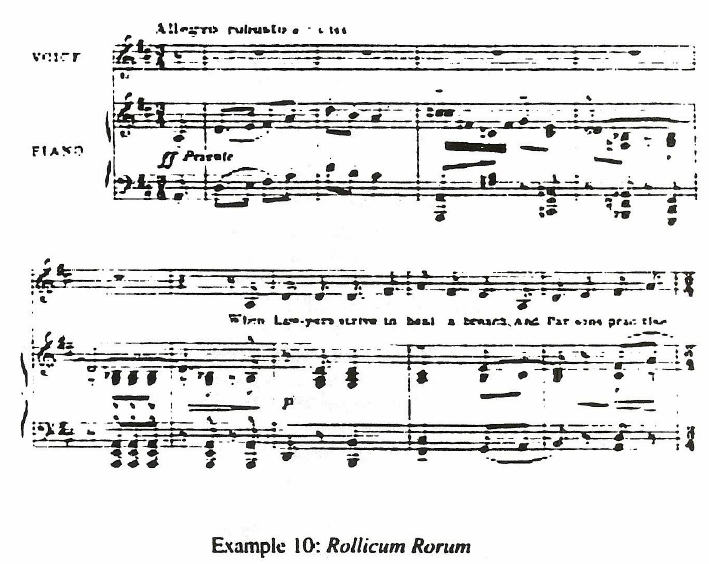
The vocal line maintains its strophic quality until the very last line where the phrase goes up instead of down. The light humor of the setting is well placed in this part of the set of songs, providing welcome contrast. The regular phrase structure provided by Hardy and matched by finzi, not characteristic of either, is also made to sound fresh in this context.
The preceding was an analysis of Rollicum-Rorum by Curtis Alan Scheib. Dr. Scheib extended permission to post this excerpt from his dissertation on February 17th, 2012. His dissertation dated 1999, is entitled:
Gerald Finzi's Songs For Baritone On Texts By Thomas Hardy: An Historical And Literary Analysis And Its Effect On Their Interpretation
The excerpt began on page forty-three and concluded on page forty-four.

